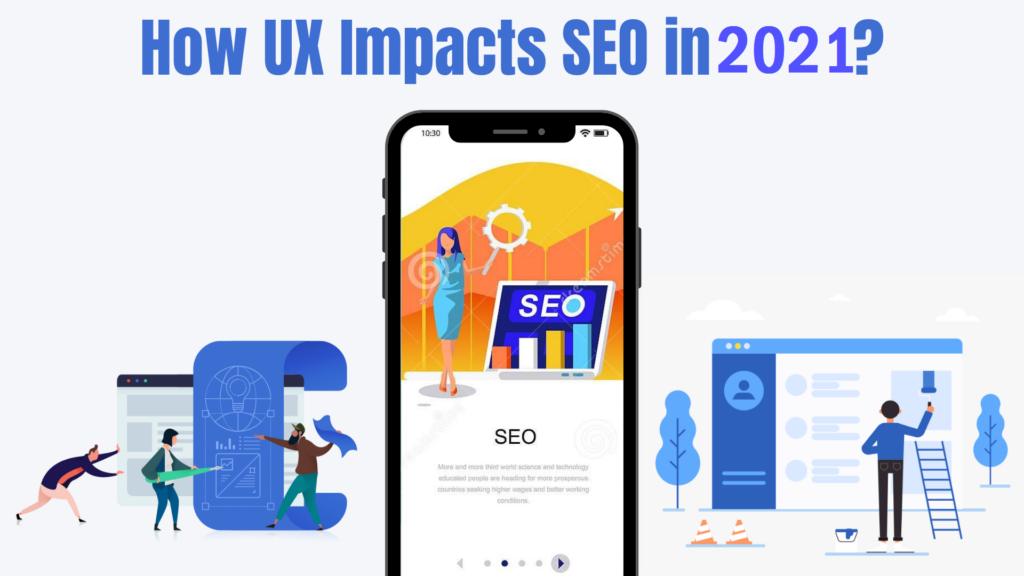What is User Experience (UX)?
A website is created for some mere basic reasons:
- You are answering a user’s query.
- You are providing a service.
- You are selling something.

In a nutshell the basic purpose for a website would be to facilitate an end user’s needs and the User experience is learning how people interpret your web interface, and how it communicates. Its main purpose is to create a web experience centered on users, with an emphasis on points. Points where the interface confuses the user.
How UX Impacts SEO in 2021? Share on X
Back in the 90’s SEO was more search oriented that meant stuffing keywords to increasing relevance for the content and ranking that on the top of the SERP’s, ultimately quality engineers from all the search engines realized that they have to provide their user base with an exceptional experience or they would lose that and a part of that was to penalize the websites which just search centric and don’t provide any value to the end user.
Good UX design helps identify what the users are searching for. This also helps reach the audience, and this would have a significant impact on the various Google usage metrics and Bing apply in their search rankings. Concentrating on making user experience enjoyable can have a “trickle-down” impact on your search ranking. You make Google and Bing proud, and you make your viewers satisfied.
Furthermore, Core Web Vitals is confirmed as a Google ranking signal and it also facilitates and confirms to the online world that user experience and site speed are of much importance.
If you are looking forward to improving your website’s performance and speed you can hire a Well Reputed SEO Company in Dubai who can help you with your efforts for improving the UX and Performance and better affecting your SERP’s ranks.
Why is UX important for SEO?
UX mixes in with SEO, as they hold similar strategies. If you’ve been following SEO over the last couple of years, you’ll know it comes with the search terms for ranking purposes. Now it aims to deliver data to searchers that want responses to their queries. That is where UX and SEO begin to engage.
Both also uphold the aim of assisting people to perform their tasks by presenting useful information to them. SEO will enable a man to the details they need, and when a user ends up on the website the UX will respond to the queries.
Impact of UX on Search Engine Optimization <> The Overlap
We might cover a number of different metrics here, but we’re going to concentrate on those that have the most effect on your search ranking.
1. Higher Conversion Rates
Traffic is almost always the primary goal of any SEO strategy. You may need to do something with those people, such as converting them into consumers, working on your email list, or getting them to share their content. Whatever the SEO target, improving is definitely in the plan and with the poor user experience, you will never optimize those.
The easiest way to describe this partnership will be that SEO is taking traffic to the website and Good UX is helping to turn them into leads and/or clients.
SEO is a technique for lead generation and organic search usually offers opportunities in earlier stages of the customer cycle than paid search. To maintain these connections along the purchase path, you will always prefer to begin with a secondary conversion objective, such as email signup or content download, so you can keep engaging these users with specific messages and directing them to the finish line.
You have quality content and powerful UX performance to attain this, removing conversion obstacles at all stages of the consumer route.
2. Page Speed

To web users, there aren’t many aspects more irritating than waiting for a sluggish website. Every passing second, the viewer is becoming more and more likely to leave the website even before it loads up. While the page has never been loaded, this would be poorly registered and enhance the bounce rate.
Recently Google made a lot of updates to its core algorithm to better understand all these issues, a recent study conducted by Google confirmed that over 67% of total searches happen from high end mobile devices and tablets confirming the fact, as part of providing users with best user experience Google is working hard ensuring that all the searchers find mobile friendly websites.
A Lot of factors affect how users perceive a landing page, as a webmaster we need to ask ourselves before making any changes in terms how would a user be affected by that change if you are facilitating the users by any implementation or fix if you are on a right path for a successful SEO campaign in 2021.
My suggestion as an SEO Expert would be to ensure that you benchmark your website on an average 3G connection which would reflect how your Landing Page or Website performs in the worst case scenario.
Although there are a number of different perpetrators for slow site speed, few of them are in your influence. While you can not monitor the slow internet connection, you can try to ensure that your website is completely configured to guarantee the best possible loading time. This could include mining your file sizes, optimizing image sizes, and ensuring that your website allows the smallest server demands available.
3. Better Visibility
The strongest link between UX and search ranking comes from a number of signals that are indirectly related to user experience. There are three signals in particular that have a strong weighting in Google’s search algorithm because poor performance in these areas tells Google that users clicked on the wrong page.
Such signs are:
- Bounce rate: Typically, high bounce rates tell Google that your website did not offer what a user was searching towards such a point that they chose to leave instead of visiting another website page.
- Time on the website: When a user spends a lot of time on one website and then leaves, then they’ve got what they need which tells this bounce can be read as an optimistic sign.
- Pages Visited: Again, a low number of pages visited isn’t always unfortunate but poor performance across these three signals indicates you’re not delivering what users want.
We have also run several experiments and have seen that Google alters your SERPs sometimes and tailor them to what users might be looking for if you have covered all those details in your landing page.
If you are producing organic search traffic then it implies that users are engaging with your subject, heading, and meta tags. At the very minimum, your search result has notified people that what they are seeking for can contain your content.
From the above points, therefore, it is clear that we should not ignore the value of UX in your SEO strategy; the user experience is key to success.
Sit back! Take the time to think about the elements that lead to UX, analyze the current state of UX, and use popular strategies to help position the website for people.
Recommended Read:
HOW TO USE VIDEO MARKETING FOR BRAND AWARENESS IN 2021?
BEST LINK BUILDING TECHNIQUES FOR NEWBIE BLOGGERS
20 CREATIVE WEB DESIGN TOOLS TO CREATE STUNNING WEBSITES
General FAQs
User experience (UX) design should be an integral part of any SEO strategy. It directly affects your SEO rankings through the various user-engagement metrics that Google employs in its search algorithms. User experience design starts by understanding how users perceive and interact with your website.
This is where UX and SEO start to interact. Both share the goal of helping users to complete their tasks by providing them with relevant information. SEO will lead a person to the content they need, and the UX answers their queries once a user ends up on the webpage.
Organic click-through rate is a good KPI to measure the quality of your website. If web searches like what they see, they’ll dig deeper into your site. A CTR is a straightforward metric: It’s the number of times a search result gets clicked, divided by how many views (or impressions) the search result has received.




